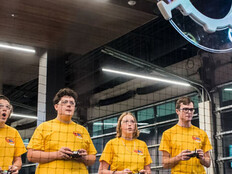Building a STEAM Curriculum? 7 Key Guidelines for Districts
As the STEAM curriculum movement grows, more and more schools are integrating the arts into their STEM curriculum. Those who have already made the transition offer these suggestions for schools just getting started:
Avoid the "Traditional Pull"
Dr. Jo Green-Rucker, the DeSoto (Texas) Independent School District's assistant superintendent for curriculum, instruction and high schools says students, teachers, parents and administrators are comfortable with traditional schools, and it's hard to get them to embrace something entirely new.
The traditional pull may manifest itself in questions such as why students aren't getting homework or whether the curriculum will prepare students for state standardized tests. To alleviate such concerns, DeSoto's three iSTEAM3D academies held parent information nights, during which parents were asked to compare the material covered in the curriculum with questions on the state tests and then work in groups to present their findings.
The activity ultimately answered their questions and gave them a chance to experience the value of the school's inquiry-based approach. "We treated them just like the students," Green-Rucker says.
In hindsight, she adds, those meetings should have happened long before the schools even opened. "We should overcommunicate," she says.
Don't Underestimate the Need to Retrain Teachers to Accommodate a STEAM Education
DeSoto ISD spent a lot of time training teachers how to shift to problem-based learning, but not enough on classroom management. As a result, many teachers struggled with keeping students focused and on task.
To avoid similar problems in the future, classroom management strategies will serve as the academies' main professional development focus this summer, Rucker says.
Give Your STEAM Learning Time to Set In
"It takes a year of transitioning to the STEAM mindset and getting your staff to really gel as a team, to learn to talk to each other," says STEAM consultant Georgette Yakman. It's also important to get all staff involved in the transition to a STEAM framework that works best for the entire school. "By the following fall, you'll have a family. Everybody will really respect each other's expertise in the school."
And that doesn't necessarily mean that subject experts will always take the lead in their topics. A child who excels in science but struggles in English might respond better to a science teacher's explanation of the value of writing.
Don't Set it in Stone
A STEAM curriculum provides a structure for the staff to have adaptable lesson plans that will flex along with society, Yakman says. That way, regardless of the direction that education technology heads or the new gadget or platform that emerges, the STEAM framework can accommodate the different elements as they evolve.
Make Collaboration a Priority
Carve out time for core and extension teachers to meet and plan with each other. Some of it can be done online, but face-to-face meetings are important too, Yakman says.
Start Small
Before taking on a huge project, figure out what works and what doesn't, and get used to the personalities and strengths of the teachers, Yakman advises.
At the beginning of a STEAM program, projects should last no more than a week or two and shouldn't be overly complex. Yakman suggests that teachers start with a tinfoil boat project, in which groups of students design foil boats that can withstand the most weight. All that's needed are a roll of aluminum foil, a ruler, a plastic tub, water and 400 pennies.
Don't Start from Scratch
Many educators teach STEAM activities without even realizing it, so start to collect examples from your staff. Also, reach out to businesses in the area to get involved. For instance, employees from Raytheon work with students in the robotics club at nearby Andover High School.
Interested in learning more about STEAM? Read our feature story "Schools Shift from STEM to STEAM" for more insights.







